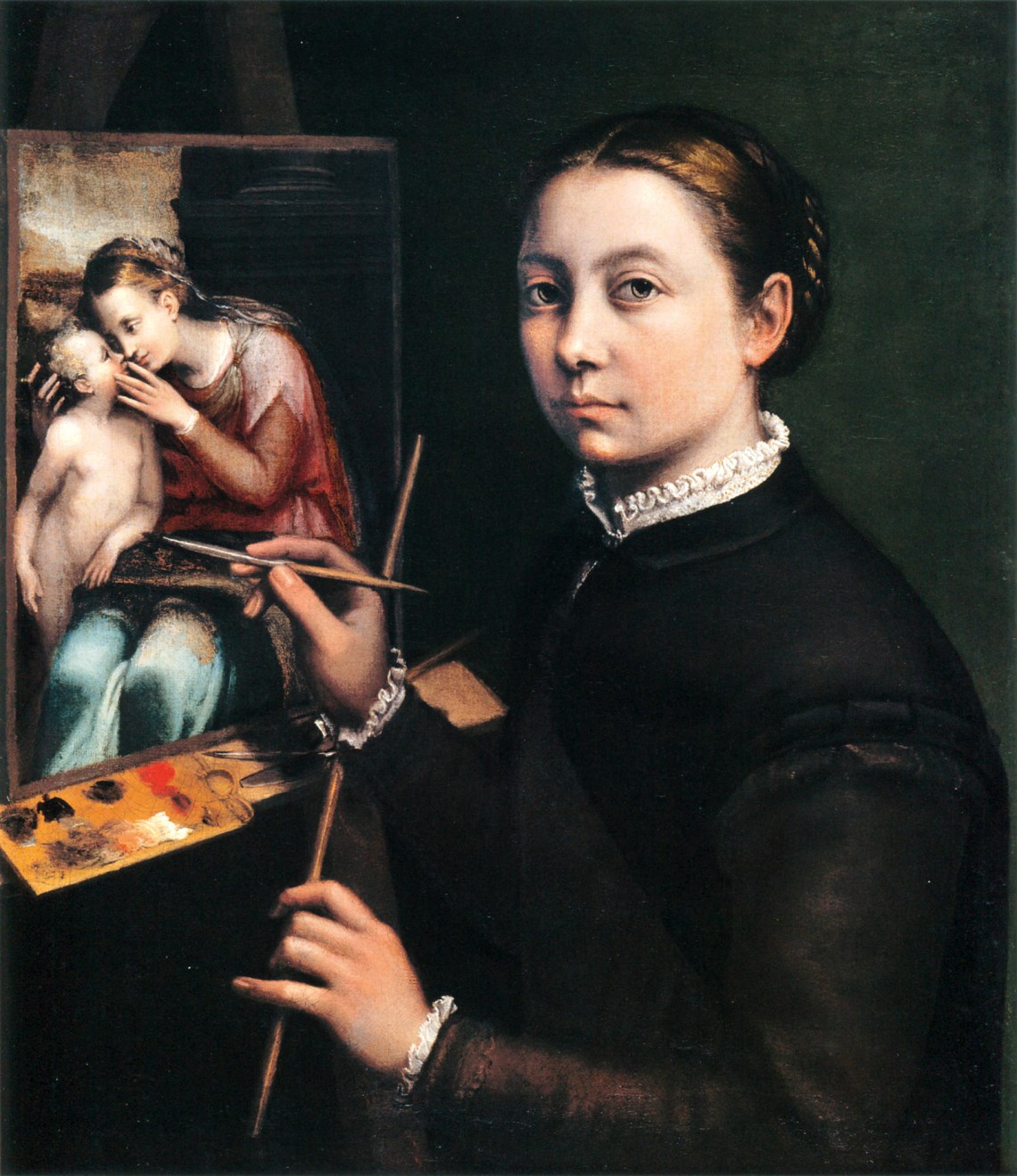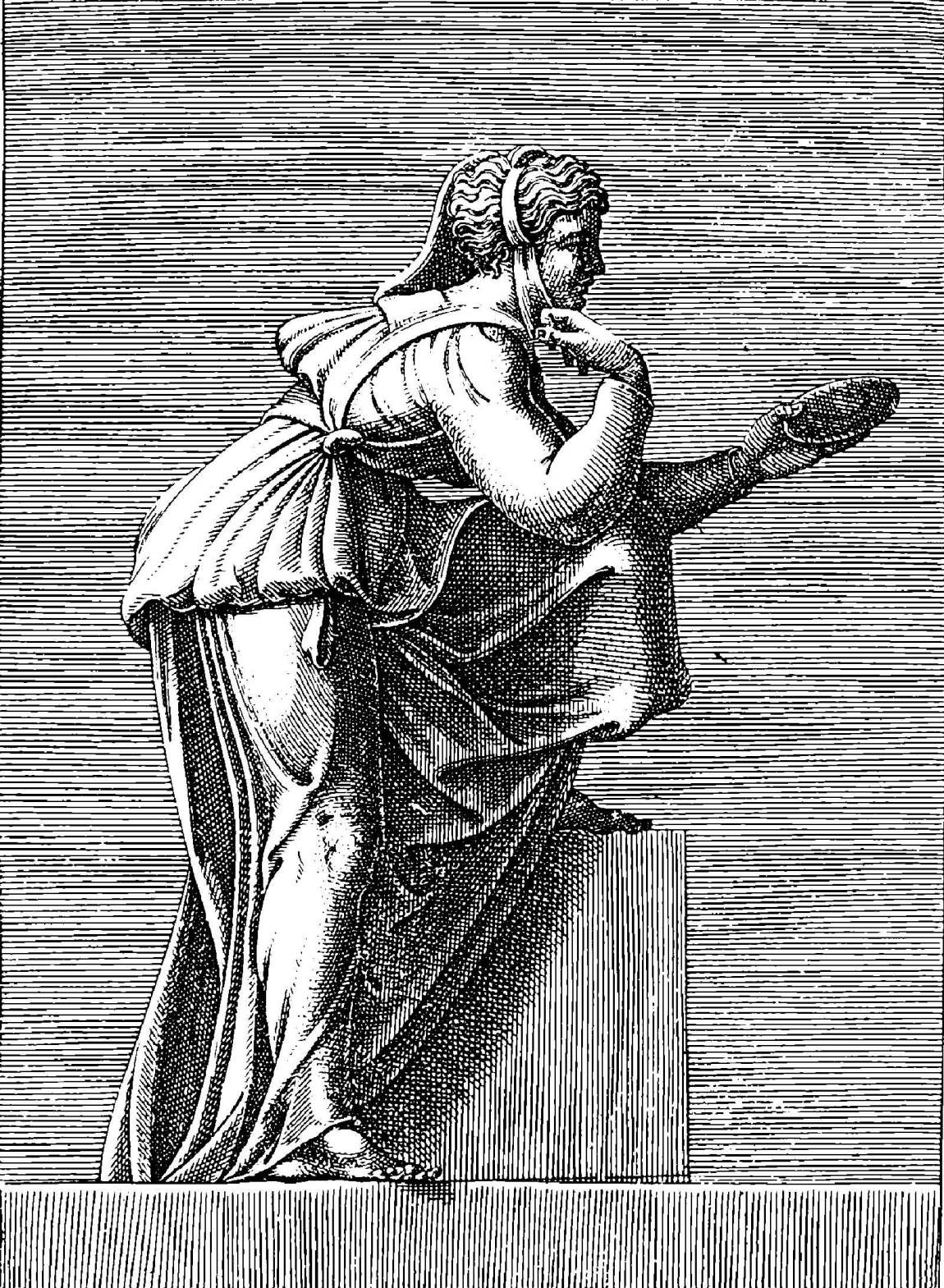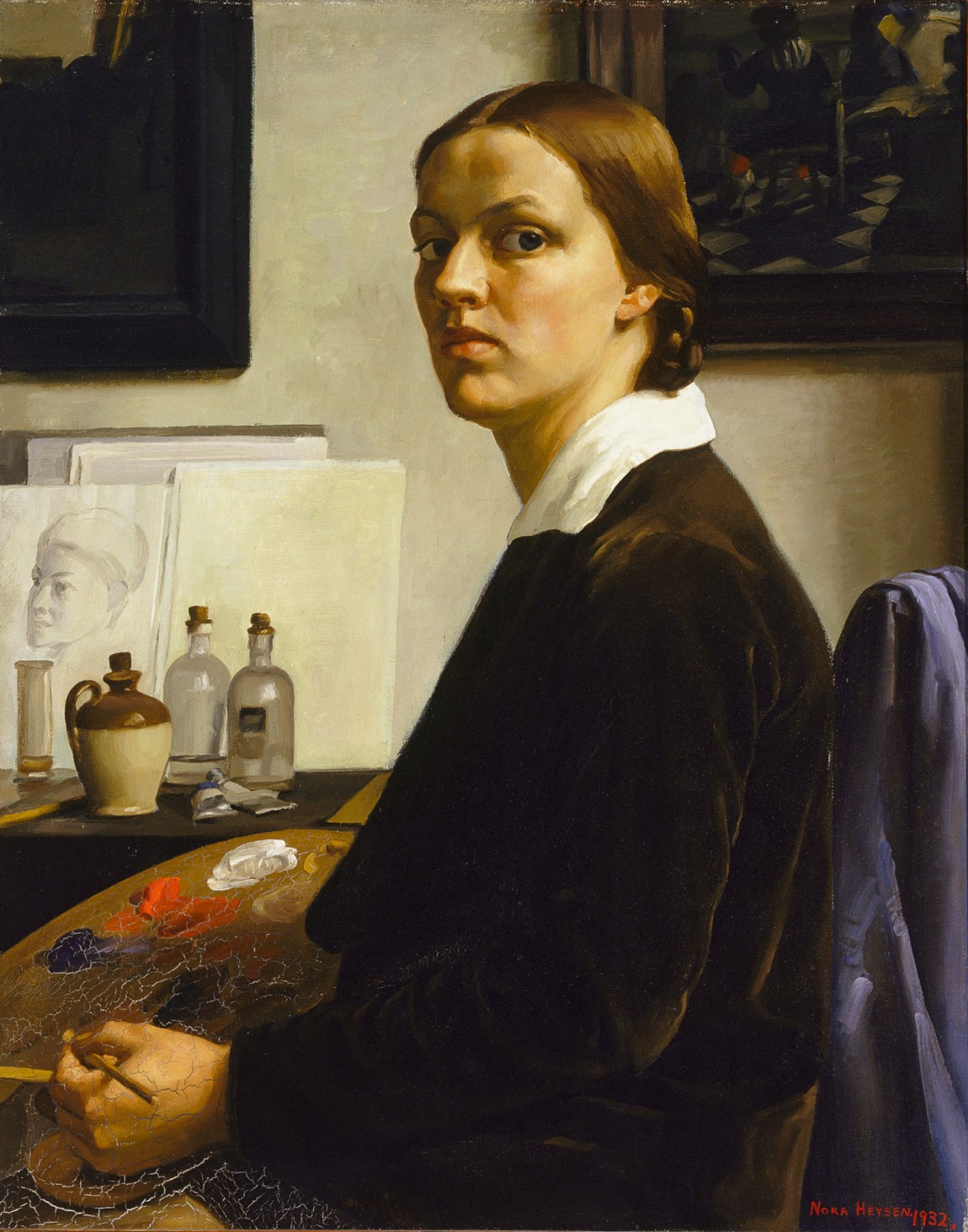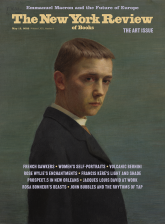Among the legendary figures whose stories Giovanni Boccaccio relates in Famous Women (1361–1362) is a Roman virgin named Marcia, who earned her fame as much for her skills as an artist, he tells us, as for her chastity. Both outpacing and outearning her contemporaries, the energetic Marcia is said to have worked in ivory as well as paint, but the only object Boccaccio specifically describes is a self-portrait, “painted on a panel with the aid of a mirror.” A charming illumination from an early-fifteenth-century French manuscript shows Marcia at work on the picture, her visage tripled, as she gazes at the small convex mirror reflecting her face in her left hand, while her right wields a brush with which she touches up the lips of the painted image.
It’s tempting to imagine that the unknown illuminator was also a woman, who perhaps amused herself by multiplying her own features in multiplying Marcia’s. Presumably she would have been less amused to learn that Boccaccio nonetheless seems to have judged the admirable Marcia an anomaly. The Greek painter Irene “merited some praise,” he explains elsewhere in the book, “because the art of painting is mostly alien to the feminine mind and cannot be attained without that great intellectual concentration which women, as a rule, are very slow to acquire.”
While a half-century of feminist art history has provided us with all too many such passages, it has also taught us to recast the terms in which they are formulated—to understand women’s relative lack of artistic achievement not as a consequence of “the feminine mind” but of institutional constraints that, deliberately or not, prevented them from receiving the training and encouragement that might have enabled their gifts to flourish. Linda Nochlin’s “Why Have There Been No Great Women Artists?” (1971) famously adduced the taboo on drawing from the nude model, a fundamental exercise for anyone who aspired to paint those grand scenes from myth and history that long ranked as the pinnacle of the art.
Other institutions, from the apprenticeship system to the royal academies, posed related obstacles, as did, of course, the pressures exerted by husbands and families. It’s clearly not by chance that Boccaccio describes Marcia as both legally independent and a lifelong virgin, or that he tells us how she avoided painting images of men, lest the ancient custom of rendering them in the nude conflict with her “maidenly delicacy.” What she obviously could do, on the other hand, was paint her own portrait. All she needed has been laid out with precision by the medieval illuminator: a set of brushes and paints, a support for the picture, a palette, and a mirror.
Studies of the self-portrait have often emphasized the centrality of the mirror to the development of the genre, but Jennifer Higgie argues that its reflecting surface proved particularly liberating for female painters. “It meant that, for the first time, their exclusion from the life class didn’t stop them painting figures,” she declares early in The Mirror and the Palette. “Now, with the aid of a looking glass, they had a willing model, and one who was available around the clock: themselves.”
The point is well taken, even if the chronology behind these somewhat breathless pronouncements is notably loose. Higgie begins her account with the story of Marcia, whose mirror-assisted picture can in turn be traced back to a report by Pliny the Elder in AD 77 of a female painter named Iaia of Cyzicus—the first recorded allusion in Western literature, as it happens, to a self-portrait painted with a mirror. Immediately before the lines just quoted, Higgie refers to the mass production of mirrors made possible by a German invention of 1835, but that date can hardly represent the liberating moment she has in mind, since it would exclude almost half the paintings reproduced in her book, including some particularly strong examples from the sixteenth and seventeenth centuries. In The Self-Portrait: A Cultural History (2014), James Hall argued, in fact, that the efflorescence of the genre in Europe beginning around 1500 owes more to “the late medieval fascination with the science and symbolism of mirrors” than to any developments in technology. If a number of gifted women at that time began to paint themselves too, they may have been responding as much to the liberating opportunities opened up by other artists as to some newfound access to their own reflections.
There is, however, a striking difference between the images they produced and those of their male counterparts, and in this, too, the illumination of Marcia is exemplary: from the beginning, the women chose to show themselves at work. While male artists of the period typically sought to elevate their status by representing themselves as gentlemen, far removed from the material business of painting, female artists seem to have been more concerned to demonstrate that they could handle a brush as well as anyone.
Advertisement
In 1548 the Flemish painter Catharina van Hemessen produced what is generally regarded as the first self-portrait of any artist in the act of painting. Clutching a tiny palette and set of brushes in one hand and propping the other on a maulstick as she grasps the brush with which she apparently outlines her own head on a canvas, the creator of this Self-Portrait at the Easel seems determined to crowd as many of the tools of her trade into its small surface as possible.1 (The entire picture measures approximately 12 by 9 1/2 inches.) Lest anyone doubt the significance of the image, she also took care to add an inscription in Latin: “I Caterina van Hemessen have painted myself/1548/Her age 20.”
The difference women made is vividly on display in Natalie Rudd’s The Self-Portrait, which begins its brief survey of the genre with the magnificent painting of a man in a red turban by Jan van Eyck that Rudd says is often considered “the earliest autonomous self-portrait (one with the artist as the central focus) in existence.” It follows that up with Albrecht Dürer’s depiction of himself in the likeness of Christ (1500) and Parmigianino’s Self-Portrait in a Convex Mirror (circa 1523), among other works, before turning to the book’s first female artist, Sofonisba Anguissola, who also provides its first image of a painter at work. (The artist, in her mid-twenties at the time, would go on to become the most prolific self-portraitist in Europe between Dürer and Rembrandt.)
Completed around a decade after Van Hemessen’s picture, Anguissola’s Self-Portrait at the Easel Painting a Devotional Panel (circa 1556) bears some notable resemblances to its predecessor, from the half-length format to the artist’s pose and the orientation of her hands. Indeed, the resemblances are so conspicuous that Higgie, who includes both pictures, finds herself wondering whether the two women might have met: a speculation at once encouraged and frustrated by the knowledge that they nearly crossed paths at the Spanish court of Philip II, where Anguissola arrived not long after Van Hemessen, who had been invited there by Philip’s aunt Mary of Hungary, had departed.
But by representing herself in the act of painting a Virgin and Child, the Italian artist also does something different from her Flemish predecessor—at once demonstrating her skill as a history painter and implicitly identifying herself with the patron saint of artists, Saint Luke, who is traditionally shown working on just such a picture. Another inscription drives home the argument: “I, Sofonisba Anguissola, unmarried, am the equal of the Muses and Apelles in playing my songs and handling my paints.” Acknowledging the material basis of their art evidently didn’t prevent female painters from staking a claim to its loftier aspirations too.
A still more daring self-portrait by the seventeenth-century Italian painter Artemisia Gentileschi offers a further twist on the theme. For her Self-Portrait as the Allegory of Painting (1638–1639), which was probably produced on a trip to London, she draws on Cesare Ripa’s popular emblem book, Iconologia (1593–1603), in order to equate her own energetic body with the figure of Painting itself. Artemisia adheres to Ripa’s specifications for representing Painting just closely enough to make her intentions clear—like him, she depicts a beautiful woman with disheveled black hair and a mask dangling from a gold chain at her throat—while discarding those elements that she appears to have resisted.2
As Higgie observes, Artemisia does away with the mouth covering that denotes Painting’s silence in Ripa and removes the word “imitation” from the mask, as if to convey that she imitates no one. She also ignores Ripa’s instruction that Painting’s tools should appear at the figure’s feet, where they are meant to signify that hers is “a noble exercise,” which “cannot be done without much application of the intellect.” Rather than subordinate the work of the hands to that of the mind, in other words, Artemisia chooses to show a fully embodied Painting vigorously manipulating the tools of her trade. Compared with some of the works for which she has become famous—her early Susannah and the Elders (1610), for example, or the multiple paintings of strong women committing acts of violence, like Salome with the Head of John the Baptist (1610–1615) or Judith Slaying Holofernes (circa 1620)—the premise of this picture may seem tame, but the confidence and boldness with which it was executed make for a powerful self-portrait.
Though I have suggested that women artists entered the field by rendering their labor visible rather than effacing it, their willingness to get their hands dirty—or at least to represent themselves as doing so—clearly had its limits. With the partial exception of Artemisia, who wears a brown apron over her silky dress and has apparently rolled up a voluminous sleeve on the arm nearest her canvas, no one in these early self-portraits looks as if she ever spilled a drop of paint. Van Hemessen’s arms appear to be encased in velvet; Anguissola’s wrists and collar sport demure white ruffles. In another Self-Portrait as the Allegory of Painting (1658) made two decades after Artemisia’s, the twenty-year-old Elisabetta Sirani sits at her easel in a low-cut gown and lavish cape, her hair wreathed with laurel.
Advertisement
Even the Dutch artist Judith Leyster, who flirts with propriety by parting her lips in a smile and gesturing with her brush at the groin of the man she is painting, compensates for her cheekiness by decking herself out in an elegant bodice and magnificent white ruff. Leyster’s self-portrait, which dates from around 1630, was attributed for more than two centuries to Frans Hals, until scholars finally decoded the monogram that served as her signature: “JL*”—a play on her name and leidstar, the Dutch word for “lodestar.”
For anyone who’s ever been told to smile for a camera, Leyster’s expression may seem unsurprising, but her willingness to show some teeth already represents a small departure from decorum. Higgie identifies a possible precursor in a 1554 sketch by Anguissola of a broadly smiling young girl teaching an old woman to read, but even if Higgie is right that the artist modeled the girl on herself, it seems doubtful that she meant this genre scene to be viewed as a self-portrait.
On the other hand, Anguissola may well have been the first woman painter to risk depicting herself in old age. In a self-portrait from around 1610 (not included by Higgie), the elderly artist, nearing eighty, sits firmly upright in a red chair, one hand holding a letter and the other marking her place in a book. It’s a dignified image but scarcely an exercise in self-flattery, as the painter scrupulously records her thinning hair, bulbous nose, and narrow lips pursed over a mouth evidently lacking in teeth. By comparison, Rosalba Carriera’s Self-Portrait as Winter (1730–1731), elegantly coiffed in ermine, is an idealized picture of an aging artist, though Higgie may not be altogether wrong to characterize Carriera’s representation of her own features as “brutally honest.” (Carriera, it should be noted, was twenty years younger than Anguissola had been in 1610.)
But the most haunting depiction of old age in The Mirror and the Palette comes from the brush of the Finnish painter Helene Schjerfbeck, whose Self-Portrait with Red Spot (1944) is among over twenty such images the artist completed while holed up in neutral Sweden during the final years of World War II. Schjerfbeck, who was eighty-two at the time and dying of stomach cancer, reduces herself to a hairless skull with one eye seemingly widened in terror and features that appear to be dissolving into the canvas. A single patch of bright red on her lower lip disrupts the painter’s otherwise nearly monochrome brushstrokes and adds a note of ambiguity to an already unsettling image. What looks to Higgie like “a drop of blood or a target,” Rudd—who also discusses the picture—sees as “a spirit of defiance, a spark of life.” But both writers are clearly moved by the brushstrokes through which a ghostly Schjerfbeck self-consciously enacts the process of her own mortality.
The aging face is one thing, however, the naked body another—at least when the body in question is that of a woman painting herself. Higgie organizes her book thematically rather than chronologically, and she saves her chapter entitled “Naked” for last. It starts off with what she identifies as “the earliest known painting of a naked self-portrait by a woman”: Paula Modersohn-Becker’s Self-Portrait on Her Sixth Wedding Anniversary (1906). Strictly speaking, the figure is bare-breasted rather than naked, since a white cloth below her waist conceals her thighs and genitals, but what is even more remarkable than her uncovered torso is the swollen belly that unmistakably identifies her as pregnant. To the best anyone can determine, however, this aspect of the self-portrait is a fiction: a kind of visual experiment by which she could both identify with the most traditional form of female creativity and radically break with it, announcing the pregnancy as entirely the work of her own mind and hands. Signed with her maiden initials, “P.B.,” and painted at a time when the thirty-year-old artist was seriously chafing at her marriage (“I am I,” she wrote that same year, “and I hope to become so more and more”), the work gains greater poignancy from the knowledge that its maker became pregnant the following year and died in the immediate aftermath of her daughter’s birth.
The emotional contrast with the image of another naked woman that concludes Higgie’s book—Alice Neel’s Self-Portrait (1980)—couldn’t be sharper. Neel herself painted many portraits of pregnant women over the course of her long career, but in this picture she turns her gaze on her own naked and aging body. Composed when she was as old as the century, Neel’s Self-Portrait doesn’t hesitate to depict her sagging breasts and belly or the flabbiness of her upper arms. But there is nothing flabby about how she perches on her blue-and-white chair, one hand grasping a brush while the other holds a paint rag, and looks keenly through her spectacles at the viewer.
“I paint myself because I am alone,” Frida Kahlo observed in her diary. “I am the subject I know best.” The extreme constraints under which she executed much of her work were unique to Kahlo: bedridden from the combined effects of childhood polio and a terrible bus accident in adolescence, she took to making self-portraits with the aid of a mirror suspended above her. But something like her sentiment recurs from others as well. “I painted myself because I knew her,” the Australian artist Nora Heysen remarked, adding, “With self-portraits you can be alone with yourself and not have to worry about another person.” Heysen, who compared self-portraiture to “an animal marking out its territory,” was attempting to escape from the influence of her famous father, the landscape painter Hans Heysen—one of a number of such father-daughter pairs that figure in Higgie’s book.
But even self-portraits, of course, are also made of other paintings. Higgie calls attention to some prominent cases: how Elisabeth Vigée Le Brun’s Self-Portrait in a Straw Hat (1782) pays mischievous homage to Rubens’s so-called Chapeau de Paille (circa 1622–1625), for instance, even as she tacitly corrects its erroneous French title by substituting an actual straw hat (chapeau de paille) for the beaver felt of the original; or how the Hungarian-Indian artist Amrita Sher-Gil plays on her own ambiguous identity, while offering an implicit critique of Gauguin’s exoticized figures, by posing bare-breasted for her Self-Portrait as Tahitian (1934).
At other times, however, Higgie lets similar opportunities slide. Though she notes in passing that Heysen’s Self-Portrait of 1932 poses the artist’s head against a reproduction of a Vermeer on the wall behind her, she fails to register that the work in question is The Art of Painting (circa 1662–1668), and that Heysen preserves the mirrored orientation of the picture-within-the-picture and partly obscures its female model, as if to underscore that she prefers to identify with the painter. (Heysen later characterized Vermeer and Piero della Francesca as her “gods.”) Nor does Higgie ever take up James Hall’s resonant comments on how Modersohn-Becker’s Self-Portrait on Her Sixth Wedding Anniversary at once echoes and transforms Raphael’s portrait La Fornarina (1518–1519): “Whereas that picture proclaimed the great artist’s ownership of his model (he signed her armband), Becker’s self-portrait implies that this model is self-creating and indeed self-reproducing.”
The Mirror and the Palette is not the first book on female self-portraiture, having been preceded by Frances Borzello’s groundbreaking—and more comprehensive—study, Seeing Ourselves: Women’s Self-Portraits (1998). But the fact that none of the painters in either work appeared in the standard textbooks on which my generation was raised—Higgie specifically mentions E.H. Gombrich’s Story of Art (1950) and H.W. Janson’s History of Art (1962)—is a sobering reminder that what we learn to see depends almost as much on the pen as it does on the paintbrush, especially for those whose gifts are apt to be questioned or overlooked in the first place. Recording your name is clearly no guarantee of immortality, but it’s no accident, I think, that pioneers like Van Hemessen and Anguissola took such care to inscribe what they had achieved on their canvases, or that so many of the women who figure in The Mirror and the Palette appear to have been prolific writers as well as painters.
Despite Artemisia’s unusual fame in her lifetime, few of her self-portraits survive: we primarily know about them, Higgie reports, from the artist’s voluminous correspondence. “I will show Your illustrious Lordship what a woman can do,” one such letter characteristically announced to her patron. “You will find the spirit of Caesar in the soul of a woman,” declared another. The written word also helped shape the career of the seventeenth-century British painter Mary Beale, whose advice on how to paint apricots, composed in 1663, is not only the first known piece of writing about art by a woman but one of the earliest accounts of artistic technique in English. Beale’s reputation got a further boost when a relative by marriage, Samuel Woodford, attributed a few passages of his Paraphrase Upon the Psalms of David (1667) to “the truly vertuous Mrs. Mary Beale”—an imprimatur that apparently confirmed her respectability as a portraitist, especially among the clergy.
In 1835 and 1836, the more reputationally challenged Vigée Le Brun, the favorite painter of Marie Antoinette, capped a tumultuous career in image management with three volumes of best-selling autobiography. Later in the century, the posthumous publication of The Journal of Marie Bashkirtseff (1887) turned the fiercely ambitious young Russian, dead of consumption at twenty-five, into an international phenomenon. “As a man, I should have conquered Europe,” Bashkirtseff had written in the journal four months before her death; and though it is her Self-Portrait with Palette (1880) that accounts for her appearance in Higgie’s book, she ultimately had more impact as a writer. Among the journal’s many admirers were George Bernard Shaw, Katherine Mansfield, and Anaïs Nin, as well as the twenty-two-year-old Paula Becker, who responded to its author’s example by concluding, “I’ve wasted my first 20 years.”
Modersohn-Becker’s own letters and journals in turn became posthumous best sellers and the initial source of her fame, though she, unlike Bashkirtseff, is now better known for her painting. Even the British Surrealist Leonora Carrington, who explicitly downplayed the power of words—“There are things that are not sayable. That’s why we have art”—was a writer as well as a painter, whose memoir and short stories provide Higgie with keys by which to unlock, however partially, a mysterious Self-Portrait (1937–1938) with a lactating hyena and a rocking horse.
Avowedly “meandering and personal,” Higgie’s book is surprisingly word-heavy for a study of visual art: her publishers have chosen to reproduce only twenty-seven pictures, one of which goes oddly unmentioned in the text. (There are more reproductions of women’s self-portraits in Rudd’s short handbook than in The Mirror and the Palette, despite the fact that Rudd aims to survey the entire genre.)
Though Higgie is herself a painter, she appears at least as concerned to offer readable accounts of her subjects’ lives as to analyze their work, especially its more material dimensions. In 2005–2006 the National Portrait Gallery in London and the Art Gallery of New South Wales cosponsored a major exhibition on the self-portrait from the Renaissance to the present that deliberately confined itself to oil painting, on the grounds that “the mirror-like gloss and perceived transparency of illusionistic painting in oils dramatises the relationship between the images of themselves that artists observed in mirrors and the perfect paintings that they produced,” but Higgie doesn’t engage the argument, despite her interest in mirrors.3 Nor does she always make clear the medium in which her subjects were working, though unlike Rudd—whose expansive definition of the self-portrait includes everything from a plaster torso by Louise Bourgeois and a Faith Ringgold quilt to installation art like Tracey Emin’s My Bed (1998)—Higgie limits her self-portraits to paintings.
Among the variations on the genre with which Rudd’s book concludes are several that might be termed indexical self-portraits: works that originated not in mirror images but in physical traces of the artist’s presence. Emin’s My Bed partly qualifies as such a work, and so, clearly, does Piero Manzoni’s Artist’s Breath (1960), despite the fact that the balloon formerly inflated by its creator has since collapsed into a flaccid residue of its former self.
From the perspective of the past several years, however, perhaps the most evocative such object in Rudd’s collection is another work by a woman artist: Helen Chadwick’s Viral Landscape No. 3 (1988–1989). The image, which belongs to a digitally assisted series created during the AIDS crisis, was generated by overlaying cell samples taken from the artist’s own body and prints made by swirling pigments into the waves along the Welsh coastline with panoramic landscape photographs. Viral Landscape No. 3 looks nothing like a self-portrait as it has been conventionally understood. But its representation of that self’s immersion in the natural world, at once beautiful and terrifying, couldn’t be more timely.
-
1
The painting was reproduced in these pages to accompany Jenny Uglow’s review of Michael Pye, Europe’s Babylon: The Rise and Fall of Antwerp’s Golden Age, February 24, 2022. ↩
-
2
I follow the convention of identifying the artist by her first name in order to distinguish her from her father, the painter Orazio Gentileschi. ↩
-
3
Anthony Bond and Joanna Woodall, Self-Portrait: Renaissance to Contemporary (London: National Portrait Gallery, 2005), p. 11. ↩






